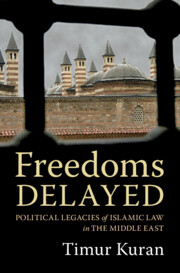Book contents
- Freedoms Delayed
- Freedoms Delayed
- Copyright page
- Dedication
- Contents
- Figures
- Tables
- Preface
- Part I The Modern Middle East’s Authoritarian Face
- Part II Persistent Social Atomization
- Part III Religious Repression
- 7 Religious Freedoms in Middle Eastern History
- 8 The Marginalization of Islam
- 9 The Resurgence of Assertive Islamism
- 10 Religious Diversification, in Fact and in Law
- 11 The Absence of Liberal Islamic Schisms
- Part IV Economic Hindrances
- Part V Conclusion
- Notes
- Bibliography
- Index
8 - The Marginalization of Islam
from Part III - Religious Repression
Published online by Cambridge University Press: 20 July 2023
- Freedoms Delayed
- Freedoms Delayed
- Copyright page
- Dedication
- Contents
- Figures
- Tables
- Preface
- Part I The Modern Middle East’s Authoritarian Face
- Part II Persistent Social Atomization
- Part III Religious Repression
- 7 Religious Freedoms in Middle Eastern History
- 8 The Marginalization of Islam
- 9 The Resurgence of Assertive Islamism
- 10 Religious Diversification, in Fact and in Law
- 11 The Absence of Liberal Islamic Schisms
- Part IV Economic Hindrances
- Part V Conclusion
- Notes
- Bibliography
- Index
Summary
The Middle East’s modernization drives initiated in the 1800s transferred power in stages from clerics to secular officials. Turkey’s secularization under Atatürk and İnönü is the boldest effort in this vein. Other ambitious campaigns occurred in Iran under the Pahlavis, Egypt under Nasser, and Tunisia under Bourguiba. These regimes might have been expected to facilitate exits from Islam, radically reinterpret the Quran, and broaden religious freedoms generally. In fact, they simply made it easy to ignore Islam. Their ideal was to have citizens disconnect their public selves from religion, and they felt justified in imposing their preferences on the masses. Indeed, they treated certain Islamic practices as archaic and drove them out of the public realm. Just as heterodox Muslims were once repressed as heretics or apostates, so now under secular leaders the pious were persecuted as obscurantists. In the process, modernizers constricted all discourses on Islam. Quashing dissent on religious policies, they effectively replaced one form of religious repression with another. Some secularists considered their illiberal policies transitional. Religiosity would decline with economic development, they believed, and worldviews would become secularized. But resistance from the pious led, instead, to a softening of secularist repression.
Keywords
- Type
- Chapter
- Information
- Freedoms DelayedPolitical Legacies of Islamic Law in the Middle East, pp. 133 - 146Publisher: Cambridge University PressPrint publication year: 2023



